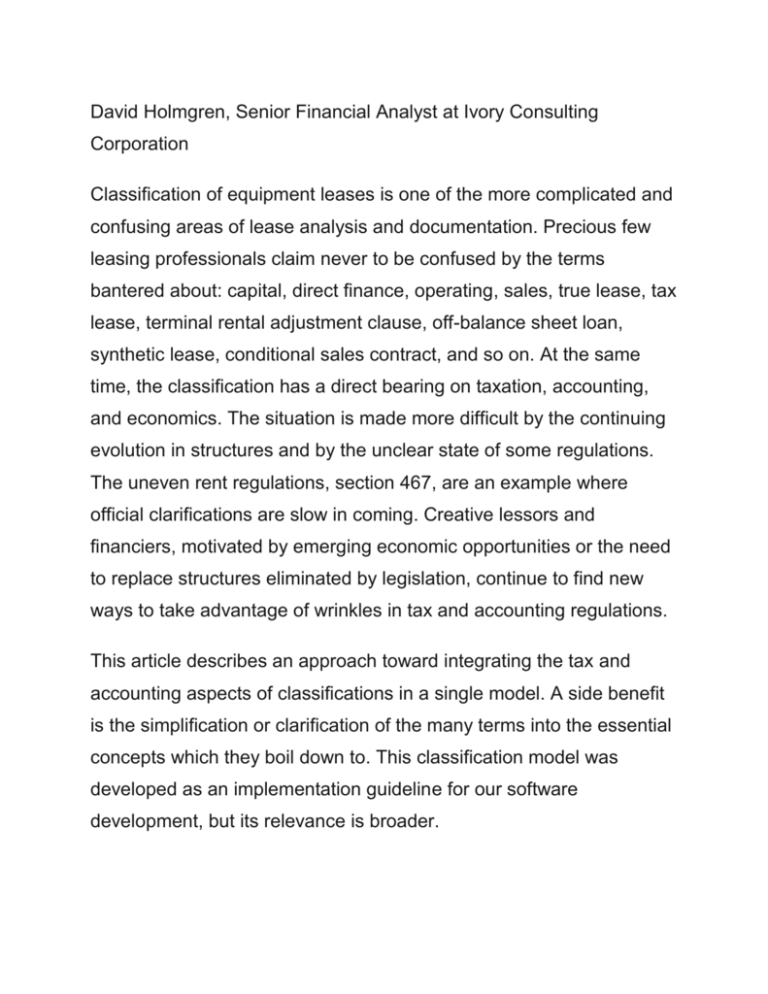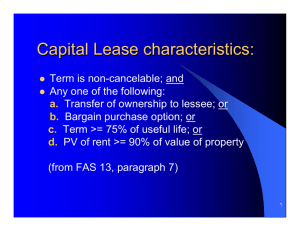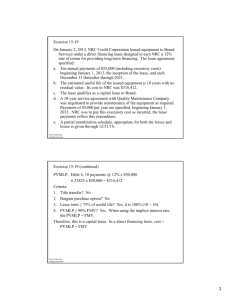Systematizing the Classification of Leases for Taxes and Accounting
advertisement

David Holmgren, Senior Financial Analyst at Ivory Consulting Corporation Classification of equipment leases is one of the more complicated and confusing areas of lease analysis and documentation. Precious few leasing professionals claim never to be confused by the terms bantered about: capital, direct finance, operating, sales, true lease, tax lease, terminal rental adjustment clause, off-balance sheet loan, synthetic lease, conditional sales contract, and so on. At the same time, the classification has a direct bearing on taxation, accounting, and economics. The situation is made more difficult by the continuing evolution in structures and by the unclear state of some regulations. The uneven rent regulations, section 467, are an example where official clarifications are slow in coming. Creative lessors and financiers, motivated by emerging economic opportunities or the need to replace structures eliminated by legislation, continue to find new ways to take advantage of wrinkles in tax and accounting regulations. This article describes an approach toward integrating the tax and accounting aspects of classifications in a single model. A side benefit is the simplification or clarification of the many terms into the essential concepts which they boil down to. This classification model was developed as an implementation guideline for our software development, but its relevance is broader. The Purpose The basic purpose of the model is to systematize the process of classifying a lease for tax and accounting purposes, based on transaction specifics. Inasmuch as these classification decisions can have economic effects, making this process clearer and more consistent should be a benefit. It also provides a framework for understanding the effects of changes in tax, accounting, or policy regulations. The endpoints for tax treatment are conditional sale contract and true lease. The accounting endpoints are operating lease, sales type lease, leveraged lease, and single investor lease. In addition, the model incorporates a "lender mode" selection in both areas, indicating immediately that the transaction is a loan, without regard to other characteristics. The scope of the model is equipment leases from the lessor perspective, and of loans from the lender perspective. Thus, the model does not consider the perspective of a lessee, nor of a purchaser of equipment. The Rules A discussion of lease classification calls for an early clarification of whether one is speaking of tax or accounting treatment. A complicating factor is that two organizations are responsible for classifying leases, the Internal Revenue Service (IRS) for tax purposes and Financial Accounting Standards Board (FASB) for accounting purposes. The basis for the tax tests are the IRS Revenue Procedures 75-21 and 75-28 and their successors, 4.071 and others. The accounting standards are Statement of Financial Accounting Standards No. 13 (SFAS 13), as amended. The undertaking of a general classification model is made difficult by the variety of interpretations on many of the points on which these decisions turn. Consider this declaration of the IRS regarding the validity of a general approach: "Whether an agreement, which in form is a lease, is in substance a conditional sales contract depends on the intent of the parties as evidenced by the provisions of the (lease or transaction) agreement, read in the light of the facts and circumstances existing at the time the agreement was executed. In ascertaining such intent, no single test or any special combination of tests, is absolutely determinative. No general rule, applicable to all cases, can be laid down. Each case must be decided in the light of its particular facts." (Revenue Ruling 55-540, Section 4) Despite this discouraging prologue, we set out to make the best of our endeavor. To the IRS's credit, they recognize the existence of principles that are generally compelling in the absence of contradictory indications. This model encompasses some of these principles. Tax Phase The classification model, (see flowchart) begins with the tax phase,whose objective is to identify whether the transaction is a true lease or a conditional sale contract for tax purposes. (Both this and the accounting phase include choices for the user to arbitrarily select the endpoints.) This distinction has a material economic effect, as the components of taxable income for the owner/lessor are determined as follows: True Lease: MACRS depreciation tax benefits are allowed as deductions from taxable income, interest paid is deductible, and rent and residual are taxable income. Conditional Sale Contract: Cash inflows to the lessor are split into principal and interest components. The interest is taxable income. The residual is considered a balloon payment, and there are no deductions for depreciation. There may be a gain at execution of the contract in the event of an excess of the deemed sales price over the cost. The tax testing continues with a check of leverage: if it is over 80%, conditional sale is immediately assumed. This is due to the lessor having less than 20% at risk. This value is only a guideline; smaller amounts may be acceptable, depending on the nature of the asset or the industry. Lower thresholds are frequently used for high-tech equipment in particular. If leverage is less than 50%, then the 75-21 tests can optionally be bypassed, as inapplicable to non-leveraged leases. Within the range 50%-80%, these tests --- profits test, cashflow test, and the minimum equity test --- are performed. If any one fails, the transaction is assumed to be a conditional sale, and further tests are skipped. The profit test checks whether the transaction, exclusive of tax benefits, produces a profit. Adding the total rents and the estimated residual, and subtracting the disbursements of principal and interest payments, equity, and fees performs this. If the result is positive, the test is passed. The cashflow test determines whether total rent less debt service and fees is "reasonable", which typically is taken to mean 2% of the equity per year. Finally, the minimum equity test checks whether the free cash is received "too quickly." This is done by adding the equity to a pro-rated amount of profit at each point in the lease and comparing that to the cumulative profit to that point. The pro-rating is usually proportional to the percentage of the lease term. The model then proceeds to tests which are somewhat judgmental, rather than quantifiable and measurable. These, specifically, are the presence of a put, a lessee residual guarantee, bargain purchase option, third party guarantee, security deposit, and limited use property. If any of these applies, then the transaction is deemed a conditional sale and flow proceeds to the accounting phase, bypassing the remaining tax tests. (Some of these tests use thresholds for determining whether the test passes.) A put is a clause allowing the lessor to force the lessee to purchase the equipment, and a lessee residual guarantee is an assurance that the lessee will guarantee a certain portion of the residual value. Both indicate that the lessor is not carrying the full residual risk, or that the lessee has an economic interest in the equipment beyond the lease term. Depending on transaction particulars, either may determine conditional sale. A bargain purchase option is a provision allowing the lessee to purchase the equipment for an amount less than its fair market value. This too is seen as economically compelling and therefore determines conditional sale. Whether a purchase option is a bargain is determined in the model by a simple comparison of the purchase option amount to the fair market value; if it is less, it is a bargain purchase. A third party guarantee is an assurance, often in the form of insurance coverage, by a party not related to the lessee or lessor to pay a certain portion of the residual. This guarantee may apply to the "top" or "bottom" of the expected residual value. The first covers the shortfall (up to the amount of insurance) between the actual proceeds and the insured residual. The second is coverage to prevent the realized value from dropping below a certain insured amount, regardless of the expected residual value. An arm's length agreement to protect either end is a fairly standard arrangement, and should not affect true lease status, especially if a significant portion of the expected residual remains unguaranteed and/or if the lessor retains first loss exposure. In the model, 10% is used as a simplistic guideline for this test, but this area is subject to a variety of interpretations by lessors and their tax counsel. A security deposit is a significant amount (10% or more of equipment cost) paid by the lessee and held by the lessor during the lease. Closely related to a security deposit is an investment by the lessee in the lessor's operation, or particularly in the initial funding of the equipment. Such an investment could mean that the lessor is carrying less than the full risk commensurate for true lease benefits; this too decides for conditional sale. Next, the model tests whether the equipment is limited use property, a somewhat subjective point. If a "reasonable" interpretation indicates that its use is limited to the particular lessee, application or facility, then the lessor would probably be seen as having a substantial interest in continuing the economic relationship with this lessee, either as a sale or a renewed lease. This also determines conditional sale. Finally, two tests relating to the remaining usefulness of re-leased equipment are applied. First, the remaining economic life is compared to 10% of the full economic life (or alternatively, 20%, depending on the type of equipment), and the remaining economic value is compared to 10% or 20% of the original value (choice of test value to be consistent with the preceding test). If either is less than the comparison value, the transaction is deemed a conditional sale. This recognizes the circumstance that this lease will likely be the last for this equipment, so the lessor will have nothing more at risk, or, put differently, the remaining economic value will be consumed by this lease. If all of these tests are passed without conditional sale having been determined, then true lease is concluded. The only tax question still to be handled is whether the rents meet the uneven rent test. A complete discussion of this test goes beyond the scope of this article, but in general the test is passed if each year's rent falls within 10% of the average annual rent. For purposes of our model, the user has a further selection of how to handle a failure: 1) ignore it, or 2) adjust the rents. Adjusting them means leveling them per the regulations in Section 467. (It does not disqualify the true lease status.) Accounting Phase The purpose of the accounting phase is to arrive at one of the endpoints loan treatment, sales type lease, leveraged lease, single investor lease, and operating lease, and this decision will determine the lessor's balance sheet and income statement treatment. Capital lease is the collective designation for sales type, leveraged, and single investor. The intent of the capital lease designation is to recognize ...that a lease which transfers substantially all of the risks and benefits incident to the ownership of property should be accounted for as the acquisition of an asset and the incurrence of an obligation by the lessee and as a sale or financing by the lessor." (FASB current text, Section L10.103) Like the tax classification process, the accounting phase begins with the lender mode question. If affirmative, loan treatment is decided, and there are no further tests. The model then provides a choice for the user to select the accounting treatment, but in the default case the SFAS 13 tests are performed. Passing any one of these four makes the lease a capital lease. If none are met, it is an operating lease. The first is title transfer. The concept here is that if the documents state that the title to the asset will transfer from lessor to lessee, then the parties should account for the transaction as if it were a sale, since the lessee is assuming the risks and benefits of ownership. The test for a bargain purchase option is similar although less definitive. (Less definitive because the question of whether a purchase option constitutes a bargain may be subjective.) A bargain purchase option indicates that the lessee is entitled to purchase the equipment for an amount significantly less than the fair market value. Since it is reasonable to expect the lessee to exercise such an option, the lessee in effect has taken on the risks and benefits of ownership, and the transaction qualifies as a capital lease. Then the model tests whether the lease begins in the last quarter of the economic life of the asset; if so, it is an operating lease. This is because there is no particular need to account for an asset on the balance sheet if its value has already been substantially consumed. If that is not the case, but the lease term is at least ¾ of the economic life, then it is a capital lease. This is because the lease consumes the substantial value of the asset. Finally, it is a capital lease if the PV of the lessee's Minimum Lease Payments (MLP) is at least 90% of the equipment cost (discounted typically at the interest rate implicit in the lease). This tests whether the lessee's rent and other obligations to the lessor (such as a partial 3rd party residual guarantee) under the lease comprise a substantial portion of the equipment cost. This test is crucial in many structuring situations. The capital lease designation is broken down by two further tests. First, is the fair value of the equipment equal to the cost? If not equal (that is, profit is generated), the transaction is deemed a sales type lease. If equal, a direct finance lease is concluded. This is the umbrella term for leveraged and single investor leases, which are then distinguished by the model by whether the leverage is 50% or more --leveraged --- or less --- single investor. Central Decision Concepts Study of this flow process should help illustrate that certain principles are central decision concepts in lease classification. One is whether the lease transfers the substantial economic value of the asset to the lessee. Another is whether the lessor is adequately "at risk" to be entitled to true lease tax benefits, and whether the transaction is "legitimate" (i.e., makes a profit) exclusive of tax benefits. The financial participation or commitment of the lessee is also key. Nevertheless, the process is complex, and indeed, its quirks are a source of creative structuring for financiers. For example, a synthetic lease (in which the documents describe a lease, but the lessee is the tax owner) turns on the ability to account for it as a lease but to treat it as a loan for tax purposes. This model is intended to systematize the classification of leases from the perspectives of taxation and accounting. The purpose of the tax phase is to determine whether a transaction is a lease or a conditional sales contract. The purpose of the accounting phase is to determine whether a transaction is a loan, an operating lease, or a capital lease, with three sub-categories under capital of sales type, leveraged lease, and single investor lease. It should address most companies' needs as is, although individual customizations are easily accommodated. For example, for the tests which use a threshold value (e.g., 10% to consider a security deposit significant), the model can provide for user input of the threshold.






